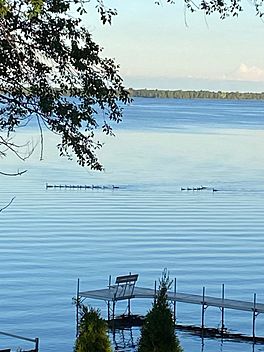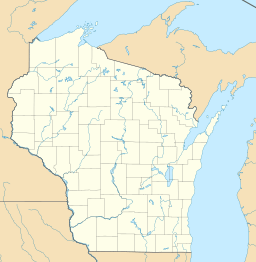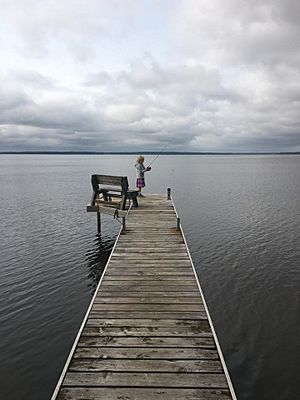Castle Rock Lake facts for kids
Quick facts for kids Castle Rock Lake |
|
|---|---|

Castle Rock Lake from the shoreline
|
|
| Location | Adams and Juneau County, Wisconsin, U.S. |
| Group | Petenwell and Castle Rock Stewards |
| Coordinates | 43°55′33″N 89°58′05″W / 43.9258°N 89.9680°W |
| Type | Drainage Basin |
| Primary inflows | Yellow River, Little Yellow River, Pentwell Lake, Big Roche a Cri, and Klein Creek. |
| Primary outflows | Wisconsin River |
| Basin countries | United States |
| Built | 1951 |
| Max. length | 11 mi (18 km) |
| Max. width | 4.3 mi (6.9 km) |
| Surface area | 16,640 acres (6,730 ha) |
| Average depth | 13.4 ft (4.1 m) |
| Max. depth | 35 ft (11 m) |
| Water volume | 172,000 acre⋅ft (212,000,000 m3) |
| Shore length1 | 72.9 mi (117.3 km) |
| Surface elevation | 885 ft (270 m) |
| Max. temperature | 82.8 °F (28.2 °C) |
| Min. temperature | 35.4 °F (1.9 °C) |
| Settlements | Germantown, Quincy, and Dellwood |
| 1 Shore length is not a well-defined measure. | |
Castle Rock Lake is a large, man-made lake in central Wisconsin. It is located in both Adams County and Juneau County. This lake is fed by several rivers and creeks, including Petenwell Lake and the Yellow River.
With a surface area of about 16,640 acres (67.3 km2), Castle Rock Lake is the fourth largest lake in Wisconsin. Its depth usually ranges from 8 to 20 feet, but some old river beds can be as deep as 35 feet. The lake has about 70 miles of shoreline. It is home to many different kinds of fish, birds, and other animals. People love to visit Castle Rock Lake for fun activities like bird watching, boating, fishing, and other water sports.
Contents
History of Castle Rock Lake
Before 1951, the area where Castle Rock Lake now sits was a valley with farmlands, wide-open prairies, and forests. The Wisconsin River flowed through this valley. For over 10,000 years, the Ho-Chunk people, who are Native Americans, lived in this lush area.
The land around Castle Rock Lake has many ancient sites. These include Effigy mounds and Petroglyphs at Roche-A-Cri Rock.
Ancient Earthworks and Art
Effigy mounds are large shapes made from earth. They were built by ancient people. These mounds can look like animals such as panthers or birds, or other shapes. They vary in size, with some being as long as a football field. Some mounds were used as burial sites for people or tools. Others were simply amazing earthworks to look at.
Just northwest of Castle Rock Lake, you can see a large rock formation called Roche-A-Cri Rock. On its southwest side, there is a cave with ancient artwork. These drawings show birds, canoes, animal tracks, moon phases, and people. Experts believe these pictures were made after 900 A.D. The Ho-Chunk people likely used these drawings for keeping records, telling stories, or even for political reasons. Even though the exact meanings might be lost, both the mounds and the rock art tell a unique story about the first people who lived near Castle Rock Lake.
Building the Dam
Later, the Wisconsin River Power Company (WRPCO) started a big project. They wanted to build a hydroelectric dam to create electricity. This project was connected to the Petenwell Dam and Reservoir. Construction of the Castle Rock Dam began in 1947 and was finished four years later in 1951. The dam is about 38 feet (11.6 meters) high and 3.5 miles (5,700 meters) long at its top. It can hold a lot of water, up to 175,000 acre-feet.
About the Lake's Environment
Geography
Castle Rock Lake is located in Central Wisconsin. It sits between Adams County and Juneau County. The land around the lake is mostly flat flood plains. The lake itself is about 882 feet (268.834 meters) above sea level. The soil in the area is mostly sandy.
Water Quality
The water in Castle Rock Lake has different temperatures throughout the year. It can be as cold as 35.4°F (1.9°C) in winter and as warm as 82.8°F (28.2°C) in summer. The water is generally healthy for fish and other creatures.
Wildlife in and Around the Lake
Plants
The plants in Castle Rock Lake are very important for the fish and other animals living there. Some common native water plants include the fragrant water-lily, common duckweed, and coontail. These plants provide good places for fish to live and hide.
However, there is also an invasive plant called Eurasian water-milfoil. This plant is not native to the lake and can grow very fast, crowding out the native plants. The Wisconsin Department of Natural Resources and the Petenwell and Castle Rock Stewards (PACRS) are working to manage this problem.
The land around Castle Rock Lake has many trees and other plants. Common trees include jack pine, red pine, black oak, white oak, and balsam fir. You can also find many ferns, like the Northern maiden hair fern and lady fern. Other plants include common milkweed, lady slippers, and black-eyed Susan.
Animals
Castle Rock Lake is a great place for fishing because of its many old river beds. These areas create good homes for fish. Many types of fish live here, such as walleye, white bass, and crappie. You can also catch northern pike, large mouth bass, small mouth bass, bluegills, and perch. Bigger fish like Muskellunge (Musky), sturgeon, and catfish are also present, but in smaller numbers.
The lake is also a winter home for bald eagles. The Wisconsin Department of Natural Resources is working to bring back wild osprey and wood duck populations to the area. The lake and its surroundings are recognized as a wildlife refuge.
The land around Castle Rock Lake is home to many other animals. You can find amphibians like the green frog and spring peeper. Common mammals include white-tailed deer, American red squirrel, common raccoon, and muskrat. Reptiles like snapping turtles, painted turtles, and Blanding's turtles live in and around the lake. You might also see snakes like the eastern hognose snake and common garter snake.
Environmental Concerns
Castle Rock Lake faces some environmental challenges. These include issues with algae, invasive species, and pollution.
Algae Blooms
Sometimes, especially in summer, you might see "blue-green algae" growing on the lake's surface. This algae can make the water look "pea green" and smell bad. It's important to avoid water with obvious algae blooms because they can cause skin rashes, eye irritation, or stomach problems if you come into contact with them.
Invasive Species
Besides blue-green algae, Castle Rock Lake has two other known invasive species: Eurasian water-milfoil and zebra mussels.
- Eurasian water-milfoil is an invasive plant. It can grow very thick and crowd out native plants. This makes it harder for fish and other animals to find food and shelter. It likely came to the United States from Europe, Asia, or North Africa, possibly through aquariums or boats.
- Zebra mussels are small, striped mussels. They also came from Europe and Asia, likely in the ballast water of large ships. Zebra mussels compete with native species for food and can harm the lake's ecosystem.
The Wisconsin Department of Natural Resources is aware of these invasive species and has plans to help control them.
Pollution from Runoff
A lot of the land around the Wisconsin River Basin is used for farming. Sometimes, rain washes soil and other materials from farms into the rivers and eventually into the lake. This is called runoff. A main pollutant in this runoff is phosphorus. Too much phosphorus in the water can cause algae to grow very quickly, leading to harmful algae blooms. For example, a large blue-green algae bloom in Castle Rock Lake in 2009 was likely caused by phosphorus runoff. Groups like the Environmental Protection Agency and the Wisconsin Department of Natural Resources are working on ways to reduce this pollution.
Fun Things to Do at Castle Rock Lake
Castle Rock Lake is a popular spot for many activities. On the west side of the lake, there are more developed areas with resorts and private docks. However, most of the shoreline is still undeveloped, which makes the lake feel less crowded and great for boating and water skiing.
There are three main beaches around the lake: Castle Rock Park, Castle Rock County Park Beach, and Buckhorn State Park Beach. The lake is also a favorite place for people who love to fish. There are ten public boat launches around the lake's large shoreline, and fishing tournaments are often held here.
The hydroelectric dam on the southern shore of Castle Rock Lake is also very important. It uses the power of the water to create electricity for nearby towns and communities.





